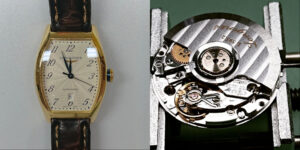We receive a huge spectrum of watches through our stores in Lewes and Uckfield, as well as through our postal repairs service. The postal service is fully insured and completely free – Using this we accept repairs from all around the UK. One watch we’ve recently had in the workshop for repair is a wonderful gold ladies Longines Evidenza.
The Longines Evidenza range was launched in 2003 and soon developed a huge number of fans. The distinctive case shape and elegant design make this range suitable for the most sophisticated of occasions. This particular model is crafted in 18ct gold, with a blued hour, minute and second hand, and a date function at the 6 o’clock position.
Powering this watch is the Longines L595.2 movement, which is based on an ETA calibre 2000-1. This is a reliable, small automatic movement, which owes much of its design to the larger ETA 2892-2 movement found in many quality gents automatic watches. The calibre 2000-1 splits watchmakers, as the design is such that many wheels are fixed directly to bridges. Were one of these wheels to need replacing, this means the entire bridge needs to be swapped.

On inspection of the movement there were no major issues to note – the watch was working, though the reading on our timegrapher was very poor, showing extremely low amplitude. This watch needed a full service and a fresh mainspring. During a full service we completely disassemble the movement and run it through our specialist watch movement cleaning machine. We also run the case through a separate ultrasonic cleaner. After cleaning, the movement is carefully reassembled and oiled, before being adjusted and tested.
Once the dial and hands are refitted to the movement, the entire watch is then cased up. With everything back together we test the watch using our specialist automatic watch testing machine. This simulates the movement of the watch on your wrist and allows us to confirm the automatic winding mechanism is operating correctly, as well as to confirm the timekeeping is within acceptable tolerances for the movement calibre.
Do you have a Longines watch in need of repair? From vintage to modern pieces, we are able to help. Thanks to our fully insured, freepost watch repairs service we are able to accept watches from all around the UK. We also accept repairs through our two stores in Lewes and Uckfield, Sussex. Our business is long established and we are Business Partners of the British Horological Institute, as well as holders of a coveted Feefo Platinum Trusted Service Award. You can be confident when dealing with us.
Yours sincerely
David Clark DGA PJDip PJGemDip CertGA
Managing Director
W.E. Clark & Son Limited


